After my recent article I wrote about the Kehoe Jig, I decided I would have to get my hands on one and give it a test.
 When the package arrived at my shop, I unpacked it and found it had quite a few pieces in it. Namely, the jig itself, the sled and magnetic stops used to make the splines, a corner inlay kit (I didn’t use it for this project), 14 degree dovetail router bit with a guide bushing, spring clamps, instructions and a paper bag containing some sample splines.
When the package arrived at my shop, I unpacked it and found it had quite a few pieces in it. Namely, the jig itself, the sled and magnetic stops used to make the splines, a corner inlay kit (I didn’t use it for this project), 14 degree dovetail router bit with a guide bushing, spring clamps, instructions and a paper bag containing some sample splines.
While reading the instruction manual, I discovered that – as with any other dovetail operation – there are two setups required. While traditional dovetail joints require you to change router setups for the pins and tails, the Kehoe requires one router setup for the grooves and one table saw setup for the splines. That’s convenient, because, unless you are lucky enough to be using two separate routers to cut your dovetails, you will have to change the router setup between the different cuts. By setting up two different tools, it helps eliminate errors and confusion.
To try the jig out, I used it to assemble the base of a photo frame bookend. I cut my oak base and riser with a 45 degree miter joint and glued it up without any additional reinforcement. The dovetail splines will take care of that.
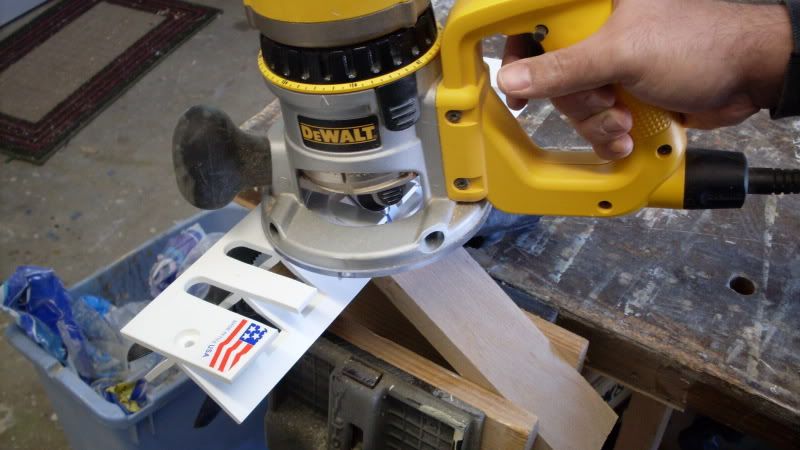 The next thing I had to do was to put the work piece into the vise and set the jig in place. This is made pretty easy, because the bottom of the jig is shaped at a 45 degree angle. This rides on the corner of the work, and the flat top gives your router plenty of support as you make the cuts.
The next thing I had to do was to put the work piece into the vise and set the jig in place. This is made pretty easy, because the bottom of the jig is shaped at a 45 degree angle. This rides on the corner of the work, and the flat top gives your router plenty of support as you make the cuts.
Before you cut, lower the bit until the bearing rides on the edges of the groove template without breaking through the inside of the joint. As you might imagine, the most critical part of this operation is to keep the router absolutely flat on top of the jig. If you lift the router while cutting, you will spoil the cut.
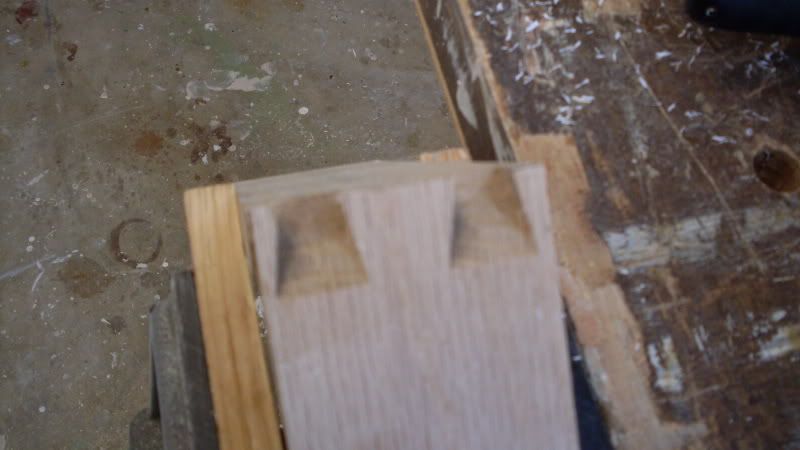 What you are left with is a dovetail-shaped groove in the work. Since the groove is relatively deep, you can now see why it is critical to not use metal fasteners. Biscuits and dowels might be OK, but, again, once the splines are driven home, they will do an excellent job in reinforcing the joint.
What you are left with is a dovetail-shaped groove in the work. Since the groove is relatively deep, you can now see why it is critical to not use metal fasteners. Biscuits and dowels might be OK, but, again, once the splines are driven home, they will do an excellent job in reinforcing the joint.
Next, you will have to move over to the table saw. First, a few notes about the splines. You want to make them by making rip cuts. You need the long grain to run the length of the splines or the joints you make will be very weak. Secondly, the spline sled gives the splines a o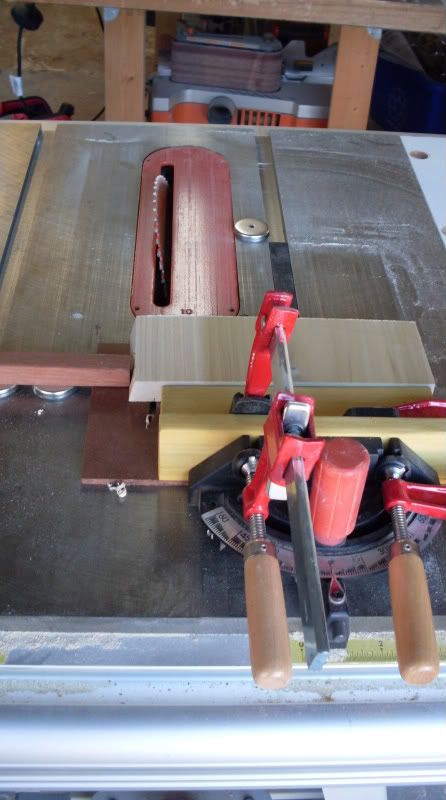 ne degree taper over their length, which means when properly cut, they will only fit one way.
ne degree taper over their length, which means when properly cut, they will only fit one way.
The setup consists of the spline sled, which clamps to your miter gauge, a magnetic stop (The device to the left of the sled with two magnets) that sets your spline’s width and a magnet that serves as a stop for the miter sled. This stop keeps you from cutting all the way through the spline sled.
To get started, first, I would strongly recommend that you glue up some panels of the wood you want to use for splines in order to get about a 12 inch width. Remember, you want these splines to be long grain. Wide boards are great, but I wouldn’t want to use a wide walnut or cherry board for this kind of operation – it’s too valuable. Set your saw’s blade to the angle of the dovetail bit you use – in this case, 14 degrees.
First, cut off one edge of your spline stock. This gives you the necessary 14 degree shoulder on one side. Next, you want to get a rough measurement of the groove at it’s widest point. In this case, about 3/4″. Mark that measurement on the stock, and set the blade to leave the mark. Push the work through the saw blade carefully, all the time holding the piece tightly to the sled’s back fence.
Take the spline to your work and see how it fits. My first attempts were too narrow. To adjust the jig, you can gently tap the stop away from the sled to widen the spline or toward the sled to make them narrower. For your first attempt, plan on making several tests to get things dialed in.
Once you hit the butter zone (where the splines slide in about halfway and then stop), cut as many splines as you need for the project. It’s always a good idea to check the spline’s width just to make sure you have’t knocked anything out of whack.
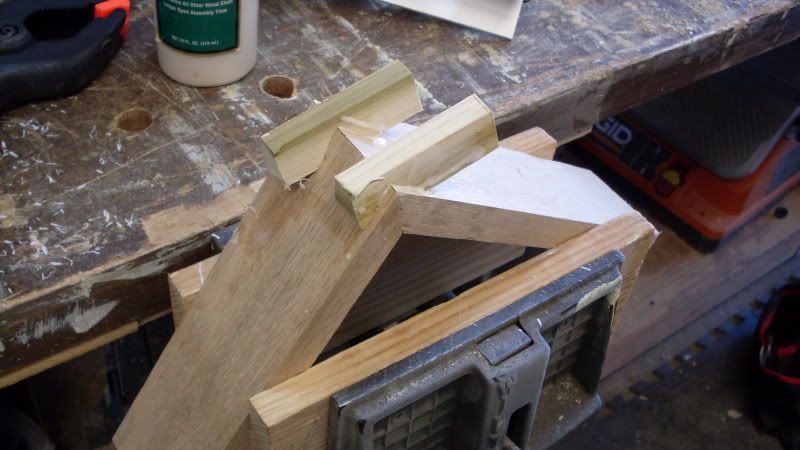 Once you get the splines ready, it’s a simple matter of gluing them up, orienting them narrow side in (remember, they have that one degree taper) and tapping them into the groove. Now, don’t club on them – you could run the risk of splitting your workpiece. Just make sure they go in tightly. Most of the glue will squeeze out of the joint as you do this, but, that’s to be expected. The very thin film of glue will hold the pieces in place very well.
Once you get the splines ready, it’s a simple matter of gluing them up, orienting them narrow side in (remember, they have that one degree taper) and tapping them into the groove. Now, don’t club on them – you could run the risk of splitting your workpiece. Just make sure they go in tightly. Most of the glue will squeeze out of the joint as you do this, but, that’s to be expected. The very thin film of glue will hold the pieces in place very well.
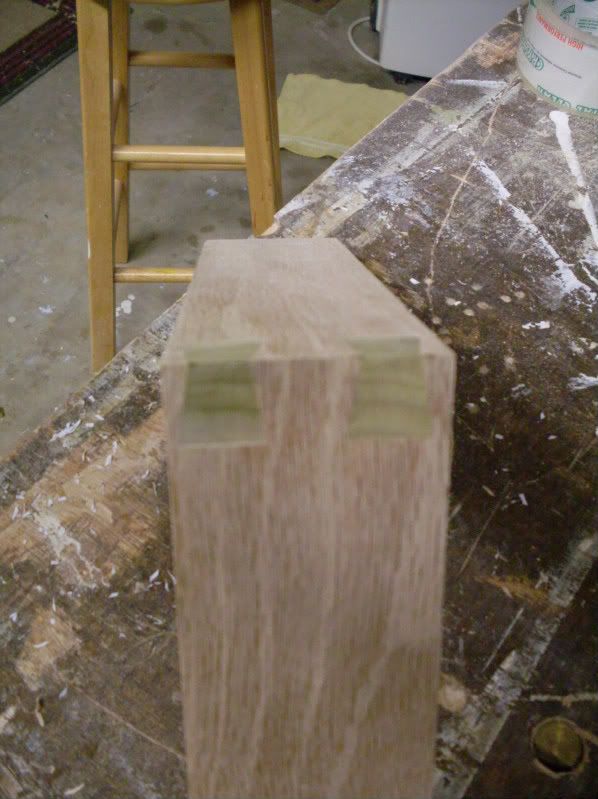 After the glue dries, you can cut the splines as flush as possible with a fine toothed hand saw (or maybe even a flush cut saw if you use a shim between the saw’s teeth and the work – you don’t want to scar the pieces) to get rid of the majority of the spline waste. From there, you can use a block plane or a belt sander to flush the splines with the work.
After the glue dries, you can cut the splines as flush as possible with a fine toothed hand saw (or maybe even a flush cut saw if you use a shim between the saw’s teeth and the work – you don’t want to scar the pieces) to get rid of the majority of the spline waste. From there, you can use a block plane or a belt sander to flush the splines with the work.
The result is a strong decorative joint that goes together faster than by using many other dovetail jigs.
Pros –
- Easy to use
- You don’t have to change router settings between tails and pins
- Ability to variably space
- Decorative
Cons –
- Takes time to zero in spline width
- Can drive joint apart if you are too aggressive with your hammer
All in all, I can recommend the Kehoe… You can find out more about the jig at their website:
http://www.dovetailspline.com/

Great review, thanks. Would you consider this jig for larger project such as blanket chests? I’ve seen the gallery and there are tables, chairs etc. but with you’re hands-on would you use the Kehoe or find another process? Such as the ‘advanced’ method of a Porter Cable 4212 of mounting the template to a board sliding it across boards wider then 12″.
Yeah, Kurt, I would definitely use the Kehoe for wider projects. The jig itself can be used for any width board, and there are fewer opportunities for measurement errors to creep in. After all, you are cutting both halves of the joints at once and then cutting splines to fit, instead of marking and measuring pins and tails.
Just cut a few splines after cutting the first length of grooves. Then, when you move the jig, you can index it off of previous grooves by using a spline through the jig. Pretty slick.
I should have chosen a more dramatic contrast in the woods for my demo, though… Hmm….
since i have the PC 4212 i will try their advanced methods for possible blanket chest sized projects and if that’s too much i’d consider the Kehoe. after reading your your post i watched a video by charles neil so i’m tempted.
thanks again
twwnetwork rocks!
Kurt –
Take pictures. If you have success, I can post ’em here for everyone to read.
BTW, no problem! That’s why I blog! 😀
Thanks for the review Tom. You did a great jog covering the basics.
On you pro and Con list I would add something to the Pro (surprise haha). The strength of the spline joints is hard to over-emphasize. Just standing there looking at them, it may not seem like a very strong joint. But our customers have put them to the test and they have withstood the test of time.
We believe that although traditional DTs have more glue surface area, the taper provides such a strong joint for the glue, traditional DTs are loose by comparison and do not press together as dramatically as the tapered splines.
On the Con re: getting the splines the correct width, once you have the knack of it, you’ll be saying “Man that is easy!”. It does have a slight learning curve but once the light comes on, you’ll be amazing yourself at how few test cuts, if any, are necessary when you go for differing spline widths.
All-in-all one of the more thorough non-video reviews I have seen on our system. Thank you for your honest and professional review, and we will keep you in mind when we release our upcoming new models this coming Spring.
Have I mentioned we have some new models being released this Spring? 😀
Oooh, new models in the spring! Kinda like rolling out the new styles on the runways in Paris! 😀
Thanks for the heads-up on the strength of the joint. I hadn’t yet put it to the test, but I’m sure as I use it more and more, I’ll find that out quickly!
I have got to hand it to you – that was a fun way to do ‘dovetails’ – I’ll be using it again!